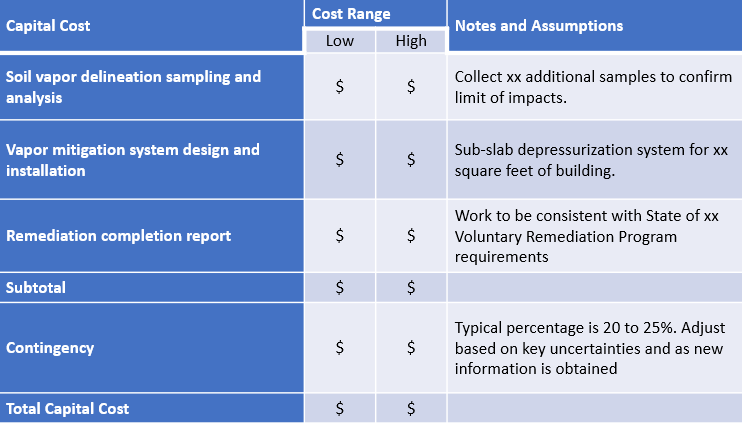Real estate transactions that identify Recognized Environmental Conditions (RECs) during a Phase I Environmental Site Assessment (ESA) often require preparation of a cost estimate for investigation, remediation and site closure. However, stakeholders often have very little data from these RECs before a decision needs to be made whether to proceed with the real estate transaction. Also, such estimates are often shared with little or no details on the assumptions used, which can lead to disagreements between buyer and seller. This blog examines how to develop a useful and defensible cost estimate during initial due diligence.
After a Phase I ESA, if there are numerous uncertainties concerning RECs, it may be difficult to develop an accurate remediation cost estimate. However, this does not mean that an estimate cannot be performed, but rather that the type and degree of uncertainties need to be defined. Experience of the estimator is important, but regardless of how estimates are developed, the purpose of the estimate should be explained, documented and reproducible, which allows stakeholders to understand the risk and evaluate potential changes in cost if additional information becomes available. An environmental cost estimating standard published by provides a good framework;[1] a basic methodology for initial due diligence is discussed below.
Example Cost Estimating Approach
Assume that a Phase I ESA for a commercial property identifies these RECs: 1) potential releases from an indoor solvent source; and 2) known groundwater contamination from an upgradient off-site source. Also, assume that:
- Soil vapor samples from beneath the building floor exceed applicable vapor intrusion screening levels.
- Groundwater samples from the property line indicate that the off-site source has not impacted the subject property
- Remediation will be conducted voluntarily, but a No Further Action letter or equivalent will be sought from a state agency.
The remediation cost estimate for this example might include the following elements:

Cost ranges for individual project elements can be developed using unit costs from similar projects and prior experience, but remediation cost estimates developed during initial due diligence are often most sensitive to the following factors:
- Time required to address environmental conditions. For example, does it need to happen right away because of pending redevelopment or can the project last several years? Groundwater cleanups might require a significant capital expense for an aggressive cleanup compared to a remedy such as monitored natural attenuation, which has a low capital but higher long-term cost.
- Delineation of impacts. Have enough environmental data been collected to define site conditions? In addition to the area and volume of impacts, the delineation needs to consider all potentially impacted media such as soil, groundwater, and soil vapor.
- Public health impacts. Are there actual or likely exposures to chemicals of concern?
Recommendations
When conducting cost estimates during initial due diligence, keep in mind the following:
- Cost estimates may have significant uncertainties, but these do not prevent an estimate from being prepared.
- Cost estimates should be well documented.
- Potential risks to human health and the environment should be considered and assigned cost as appropriate.
- Finally, although the terms “budgetary” and “preliminary” are appropriate for initial due diligence cost estimates, once these numbers get distributed, they are often mistakenly treated as firm quotes. Therefore, it is important to update these estimates as new information is obtained.
[1] ASTM E2173-17: Standard Guide for Estimating Monetary Costs and Liabilities for Environmental Matters. This standard includes a more detailed approach than described in this blog, but at this stage in due diligence, relatively simple estimating is usually appropriate.




